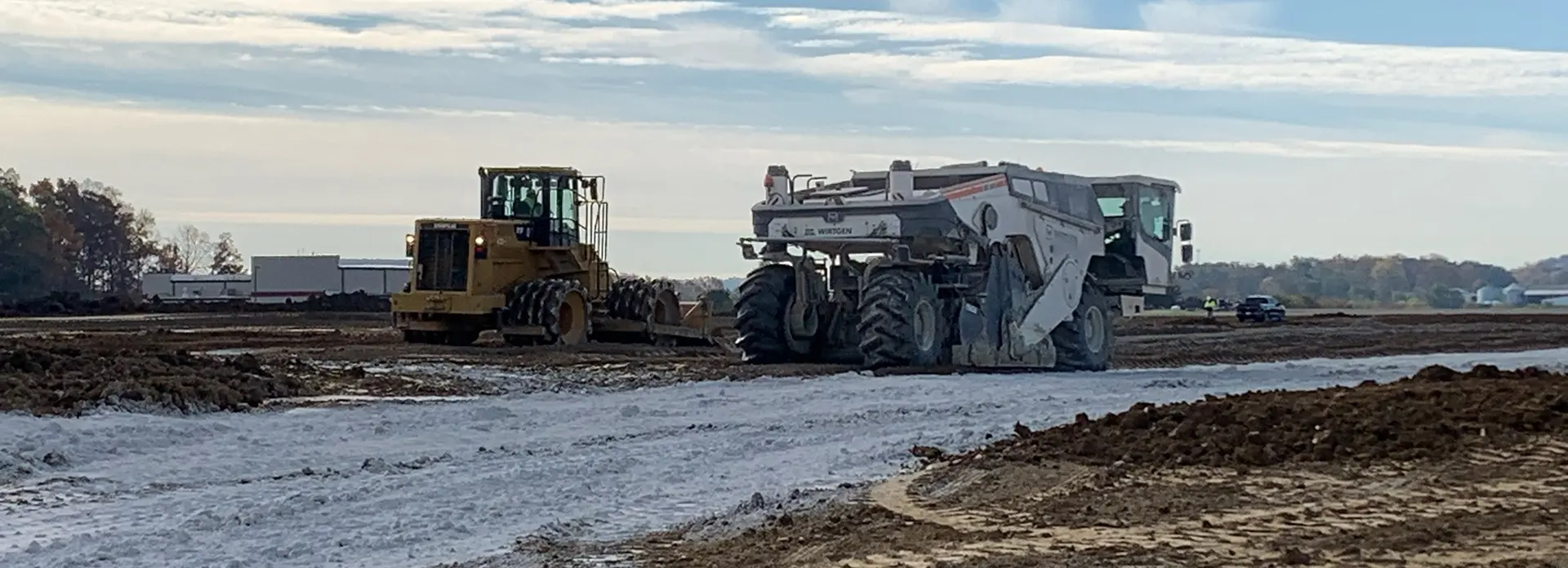A Guide to Lime Soil Stabilization Specifications

Importance and Purpose of Lime in Soil Stabilization
Lime plays a crucial role in soil stabilization, which is a process used to improve soil properties. The term lime is a somewhat catch-all term for many calcium-bearing materials, so it is important to understand the similarities and differences between these versatile materials.
Get back to work with less downtime.
Composition and Key Properties: Quicklime vs. Hydrated Lime
Quicklime is manufactured from high purity limestone deposits that have been quarried or mined, then sized and calcined in kilns at nearly 1000°C. This process transforms the stone from calcium carbonate (CaCO3) to calcium oxide (CaO). Depending on the size of the feed stone, crushers and screening operations, quicklime sizing can range from greater than one inch to pulverized products with the vast majority passing 200-mesh. In construction the vast majority is sold as a ¼” x 0 product, however, sizing can vary depending on project specifications.
Hydrated lime, sometimes simply called hydrate, is produced by further processing quicklime. Specialized equipment adds the right amount of water and agitation to chemically quench the reaction as CaO hydrates to calcium hydroxide, Ca(OH)2. The result is a less dense, dry, fine powder that will no longer react exothermically with water.
Mintek’s quicklime and hydrated lime exceeds ASTM C977 and AASHTO M 216, Standard Specifications for Quicklime and Hydrated Lime for Soil Stabilization.
Impact of Lime Characteristics on Soil Treatment
As previously mentioned, both quicklime and hydrated lime contain calcium which is essential for soil stabilization and modification. Calcium modifies the soil through cation exchange resulting in molecular flocculation and agglomeration. For stabilization, calcium is essential for developing cementitious compounds which lead to permanent strength gains. Another benefit of treating soil with lime is to dry overly wet soil. Since hydrated lime is already chemically bound with water, quicklime is the preferred product for soil drying.
The Science of Soil-Lime Stabilization
Lime stabilization involves a series of chemical reactions that improve the physical and mechanical properties of soil.
- Hydration: When quicklime reacts with water contained in soil, it undergoes an exothermic reaction forming calcium hydroxide.
- Ion Exchange: As lime solubilizes, it releases calcium cations (Ca++) that replace other cations within the soil. This exchange modifies clay particles resulting in reduced plasticity, reduced shrink-swell potential and a higher optimum moisture content.
- Flocculation and Agglomeration: As ion exchange occurs, particles cluster together to form a more granular material with improved workability.
- Pozzolanic Reaction: This is a reaction between the clay molecules (a natural pozzolan), water and calcium hydroxide that form cementitious bonds. These bonds can continue to form for months or longer depending on several factors, including soil reactivity and dosage rate.
Importance of Soil Type in Lime Stabilization
The importance of soil type in soil stabilization is significant because different soils react differently to stabilizing agents. Proper assessment and understanding of the soil type are essential for effective and efficient soil stabilization.
The physical and chemical composition of soil, including the types and amounts of clay, silt, sand, and organic matter, will determine how it reacts to stabilizers like lime or cement. Clayey soils, with their fine particles and high clay content, tend to be more conducive to lime while coarser, sandy soils tend to be stabilized with cement.
The National Lime Association states that soils containing more than 25% clay content with a plasticity index (PI) greater than 10 are generally conducive to lime treatment. Soils with higher clay content, particularly those with expansive clays, can benefit greatly from stabilization.
The inherent engineering properties of the soil, such as strength, compressibility, and permeability, influence the effectiveness of stabilization. Stabilization aims to improve these properties, but the degree of improvement depends on the soil type. Lab testing is important to determine the degree of improvement with any stabilizing agent.
Practical Application of Lime in Soil Stabilization
Once lime has been selected as the stabilizing agent for a project, the following process is typically specified by engineers and State Departments of Transportation.
-
- Preparation: The soil is first prepared by scarification and initial pulverization, which involves breaking up the soil and ensures that no large cobbles are present.
- Lime Spreading: (Quicklime or hydrated) lime is then evenly spread over the prepared soil surface at the prescribed dose.
- Initial Mixing: The lime is mixed into the soil using a specialized soil reclaimer. This step may include the addition of water to facilitate the chemical reactions necessary for stabilization.
- Mellowing Period: After initial mixing, the soil-lime mixture reacts with the soil (mellow), and the desired chemical changes begin to take place. Depending on the soil plasticity, the mellow period may be defined as follows:
| Untreated Soil PI | Mellow Period (min.) |
| PI < 18 | 2 hrs. |
| PI ≥ 18 and PI < 24 | 4 hrs. |
| PI ≥ 24 and PI < 30 | 8 hrs. |
| PI ≥ 30 and PI < 36 | 16 hrs. |
| PI ≥ 36 | 24 hrs. |
- Final Mixing and Pulverization: The soil is further mixed and pulverized to ensure homogenization.
- Compaction: The treated soil is then compacted to the required density.
- Curing Period: During this time, the pozzolanic reactions between the lime and soil continue, leading to increased strength and durability. A typical cure period lasts for 3 to 7 days, depending on acceptance criteria and temperature.
Limitations of Using Lime for Soil Stabilization
While lime treatment can be a highly effective method for soil stabilization, it’s important to understand that there are certain limitations to its use.
- Temperature plays a crucial role; lime stabilization is typically not performed when the air temperature is below 40°F (4°C), or when the subgrade material is frozen. This is because the chemical reaction between lime and water, which is essential for achieving the desired strength and stability, may not be sustained under these conditions. However, even in cold conditions, quicklime can be very effective for cold weather drying of soils. See our Cold Weather Liming Cut Sheet for more information.
- Environmental conditions, such as high winds, can lead to excessive loss of lime fines, resulting in inadequate stabilization. Therefore, spreading should be avoided under such circumstances or a consideration should be made to use a coarser “pebble” lime, which contains a limited amount of fines.
- As with any stabilized soil, premature loading during the cure period can damage the lime-treated layer before it has gained sufficient strength, so traffic and equipment access should be limited until adequate strength has been determined.
- The construction timeline is another factor to consider. Lime stabilization should not be performed on areas that will not be covered with the succeeding stage of sub-base or base construction during the same construction season, as the lime-treated soil can deteriorate if left exposed to the elements for an extended period, particularly if the treated area is not effectively graded to shed water.
- The soil composition also affects the effectiveness of lime stabilization. Soils containing greater than 3,000 ppm soluble sulfate content should be evaluated for potential expansion, as sulfates can react with lime, and other calcium bearing reagents like cement, to form ettringite, which can cause the soil to heave.
- When long term strength development is required, according to the National Lime Association, soils with at least 25% passing a 75-micron screen (clay) and having a plasticity index (PI) of 10 or greater are generally good candidates for lime stabilization.
In conclusion, while lime treatment is a powerful tool for soil stabilization, it’s essential to consider these limitations to ensure its effective and safe use. Soil stabilization is all about using the right treatment for the right soil under the right conditions.
Need help determining the best product for your next project? Let us help! Give Mintek a call today to utilize our lime experts at the Innovation Center to conduct soil testing on your specific jobsite. (937) 431-0218.
We're here to help you find the best solution for your next project. Let's get started. Give me a call at 937-641-9901.

Josh Weser
Mintek Resources
Related Posts
Ground Control: Comparing Lime and Geosynthetics for Long-Lasting Stability
When building infrastructure on weak in-situ soils, a well-designed foundation is essential to ensure long-term resilience. Whether you're constructing roads, embankments, or industrial platforms, ensuring subgrade stability is critical—not just for performance, but...
Save Time and Money with Mintek’s Lime Stabilization Calculator
Lime stabilization turns challenging soils into durable foundations suitable for the construction industry. When lime-based reagents interact with soil, a chemical process alters its characteristics - binding clay particles, reducing plasticity & shrink-swell...
Exploring The Application of Lime Stabilization in Soil
Creating a stable foundation is essential for any construction project, yet many construction sites face challenges with unsuitable soil conditions. Lime soil stabilization offers a proven, cost-effective solution for transforming problematic soils into reliable...